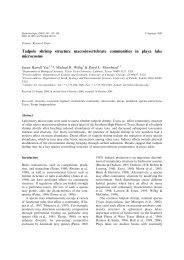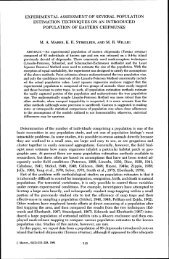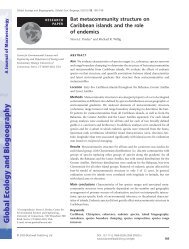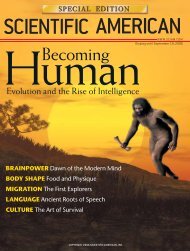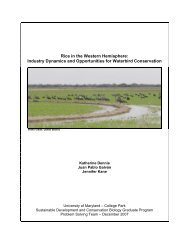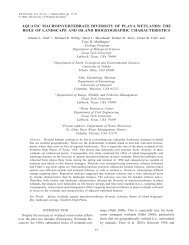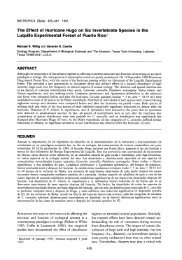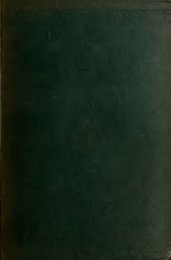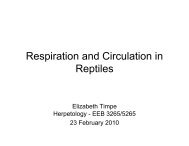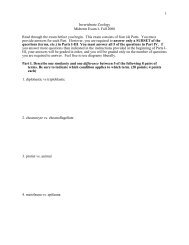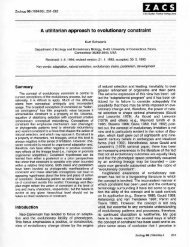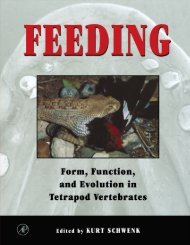Journal of Tropical Ecology (2006) - USDA Forest Service
Journal of Tropical Ecology (2006) - USDA Forest Service
Journal of Tropical Ecology (2006) - USDA Forest Service
Create successful ePaper yourself
Turn your PDF publications into a flip-book with our unique Google optimized e-Paper software.
116 CHRISTOPHER P. BLOCH AND MICHAEL R. WILLIG<br />
<strong>of</strong> O. glabra, in contrast, did not respond to the two<br />
hurricanes in the same fashion (interaction term,<br />
F1,24 = 4.37, P = 0.047). Rather, densities increased<br />
more rapidly following Hurricane Georges than<br />
following Hurricane Hugo (slopes: b1 = 1.79 ±<br />
1.05 versus –0.21 ± 0.37, mean ± SE). Although<br />
significant effects <strong>of</strong> disturbance were not consistent<br />
for all species, total density <strong>of</strong> gastropods increased<br />
linearly through time following disturbance (b1 = 109,<br />
F1,25 = 11.1, P = 0.003), and the response was consistent<br />
for the two hurricanes. The effects on N. tridens, P.<br />
portoricensis and P. acutangula remained significant after<br />
application <strong>of</strong> the Bonferroni sequential adjustment.<br />
Quadratic relationships between density and time since<br />
disturbance were not prevalent. Indeed, ANCOVA models<br />
incorporating a quadratic term were significant for only<br />
three species: A. striata, C. squamosa and M. croceum.<br />
The significant quadratic term for M. croceum was driven<br />
strongly by a single datum (an unusually high density in<br />
the wet season <strong>of</strong> 1998) and probably is not indicative<br />
<strong>of</strong> a biologically meaningful trend. For A. striata and<br />
C. squamosa, on the other hand, a genuinely nonlinear<br />
response was apparent. Densities <strong>of</strong> each were greatest<br />
approximately 2 y after each hurricane and declined in a<br />
quadratic fashion thereafter (Figure 2).<br />
Similarly to mean density, absolute spatial variability<br />
in density exhibited a significant effect <strong>of</strong> disturbance<br />
(i.e. a significant ANCOVA model) for only a subset<br />
<strong>of</strong> the snail assemblage (A. striata, Caracolus marginella,<br />
N. tridens, P. portoricensis and P. acutangula; Table 2).<br />
Alcadia striata, C. marginella and P. portoricensis exhibited<br />
both a difference in variability between the two<br />
time sequences (recovery from Hurricane Hugo versus<br />
Hurricane Georges) and a consistent linear relationship<br />
betweenvariabilityandtimesincedisturbance.Polydontes<br />
acutangula displayed only the former, whereas N. tridens<br />
displayed only the latter. The interaction between<br />
hurricane identity and time since disturbance was never<br />
significant. Densities <strong>of</strong> A. striata, C. marginella and P.<br />
acutangula were more variable following Hurricane Hugo<br />
than Hurricane Georges. Platysuccinea portoricensis was<br />
the only species to exhibit greater variability in density<br />
following the second hurricane. Variabilities <strong>of</strong> densities<br />
<strong>of</strong> N. tridens and P. portoricensis increased through<br />
time following disturbance, whereas those <strong>of</strong> A. striata<br />
and C. marginella declined. For total snail abundance,<br />
disturbancehadnoapparenteffectonabsolutevariability.<br />
The effects <strong>of</strong> disturbance on three species (A. striata,<br />
N. tridens and P. portoricensis) remained significant<br />
after the application <strong>of</strong> the Bonferroni sequential<br />
adjustment.<br />
Disturbance effects were slightly more prevalent<br />
for relative variability (variance <strong>of</strong> log density) than<br />
for absolute variability; seven <strong>of</strong> 17 species displayed<br />
significant ANCOVA models, including three (N. tridens,<br />
Density (individuals/ha)<br />
Density (individuals/ha)<br />
300<br />
250<br />
200<br />
150<br />
100<br />
50<br />
0<br />
250<br />
200<br />
150<br />
100<br />
50<br />
0<br />
(a) Alcadia striata<br />
1991<br />
1991<br />
1992<br />
1992<br />
1993<br />
(b) Cepolis squamosa<br />
1993<br />
1994<br />
1994<br />
1995<br />
1995<br />
1996<br />
1996<br />
1997<br />
1997<br />
1998<br />
Year<br />
1998<br />
Year<br />
Figure 2. Population density <strong>of</strong> (a) Alcadia striata and (b) Cepolis squamosa<br />
on the Luquillo <strong>Forest</strong> Dynamics Plot from 1991 to 2004. Error bars<br />
encompass 1 SE about the mean. Dashed lines indicate the impact <strong>of</strong><br />
Hurricane Georges.<br />
P. portoricensis and P. acutangula) <strong>of</strong> the five with significant<br />
ANCOVA models for absolute variance (Table 3).<br />
Relative variability in abundance <strong>of</strong> P. acutangula<br />
was greater following Hurricane Hugo than Hurricane<br />
Georges. The converse was true <strong>of</strong> Austroselenites<br />
alticola, O. glabra, P. portoricensis and S. octona. Relative<br />
variability increased over time following disturbance<br />
for P. portoricensis. This effect was consistent for both<br />
hurricanes. GaeotisnigrolineataandN.tridensdifferedfrom<br />
other species in that relative variability in abundance<br />
responded differently to each hurricane (interaction<br />
terms F1,24 = 5.05, P = 0.033 for G. nigrolineata and<br />
F1,24 = 7.55, P = 0.011 for N. tridens). For both species,<br />
variance <strong>of</strong> density (log-transformed) decreased over time<br />
following Hurricane Hugo but not following Hurricane<br />
Georges (b1 = –0.066 ± 0.025 versus 0.038 ± 0.038<br />
for G. nigrolineata and b1 = –0.117 ± 0.022 versus<br />
–0.018 ± 0.023 for N. tridens). Relative variability <strong>of</strong> the<br />
total snail assemblage was unaffected by either hurricane<br />
identity or time since disturbance. Effects <strong>of</strong> disturbance<br />
remained significant after application <strong>of</strong> the Bonferroni<br />
1999<br />
1999<br />
2000<br />
2000<br />
2001<br />
2001<br />
2002<br />
2002<br />
2003<br />
2003<br />
2004<br />
2004



